Fabric Paint vs. Dye: Choosing the Right One for Your Project
Want to add a personal touch to clothes or create textile art, but confused by fabric paints and dyes? You’re not alone! Choosing wrong can mean faded colors, stiff fabrics, or designs that don’t last. This guide clears the confusion, explaining fabric paint vs. dye to help you pick the best for your fabric and project goals.
Learn key application techniques and the importance of colorfastness. We’ll even recommend top brands! Gain expert knowledge to confidently create vibrant, lasting designs on any fabric. Unlock your textile creativity and achieve professional results with the right coloring method.
1. General information: Transforming textiles with paints and dyes
Fabric paints and dyes serve as remarkable tools for altering the appearance of textiles. Both methods allow one to transfer artistic concepts and creative expression directly onto fabrics used for clothing, wearable art, home décor, and upholstery. This opens up possibilities for engaging DIY projects focused on fabric design and customized textile creations.
This article will delve into the key distinctions between fabric paints and dyes, helping you decide which medium is the perfect fit for your next textile project. By understanding their unique properties and applications, you’ll be able to achieve the desired results and bring your creative visions to life.
For hundreds of years, artists have employed both fabric painting and dyeing techniques. Historically, these approaches have served as effective channels for showcasing artistic expression across a wide range of textile surfaces.
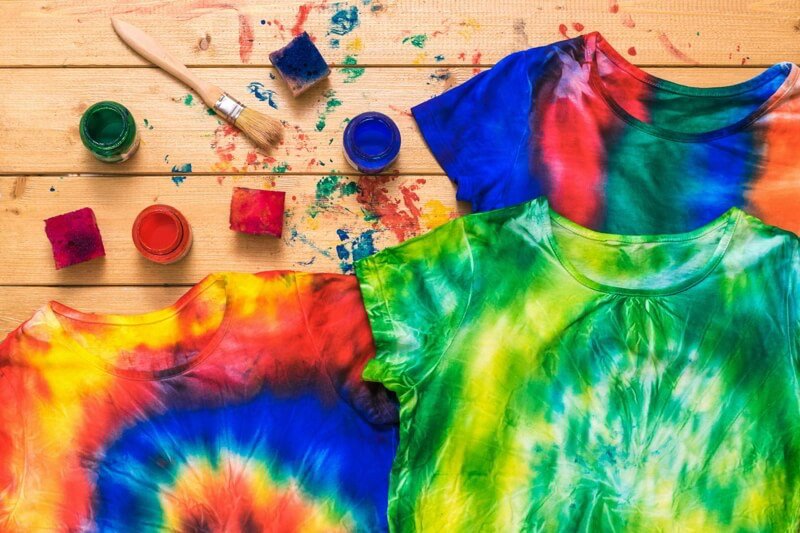
2. Fabric paints: Surface design and detailed artistry
2.1 Characteristics of fabric paints
Fabric paints encompass a range of coloring agents designed for textiles, including textile paints, fabric markers, and textile inks. Essentially, these create color by remaining on the fabric’s surface, effectively adhering to the fibers.
This surface application makes them particularly suitable for precise, detailed designs. You can easily achieve intricate patterns using application methods like brush work or stencils, allowing for direct and controlled color placement.
Furthermore, quality fabric paints offer opaque and remarkably vibrant colors. This opacity is a significant advantage, making them especially suitable for dark fabrics where dyes might not show up as effectively. Crucially, fabric paints are designed to be flexible, meaning they move naturally with the fabric and resist cracking over time.
This flexibility is key to ensuring both washability and colorfastness. While not all fabric paints require heat setting, some brands recommend it to achieve improved wash-fastness and enhance durability. For projects where fabric hand-feel is paramount, some brands offer soft fabric paints specifically formulated to minimize stiffness.
2.2 Pros and cons of fabric paints
Fabric paints present a number of appealing benefits, making them a suitable choice for specific projects and skill levels. Their ease of use is a major advantage, making them accessible to beginners. Another strength lies in their capacity to produce crisp, detailed designs, fine lines, and precise lettering. Furthermore, the bold, opaque nature of many fabric paints allows them to show up effectively even on darker fabrics.
However, they also have some potential limitations. One consideration is the possibility of the paint causing the fabric to become slightly stiff, though modern flexible formulas have vastly improved this. Another factor is durability; because fabric paint rests on the surface, it might be less durable than dye if not correctly set. Applying it too heavily or on very stretchy fabrics can increase the risk of cracking.
Practical Tip: To minimize stiffness, prioritize paints labeled as “soft” or “flexible.” Adhering to the manufacturer’s instructions for heat setting, if required, is essential for maximizing longevity, especially for items that will undergo frequent washing.
3. Fabric dyes: Immersed color and soft fabric feel
3.1 Characteristics of fabric dyes
Clothing dyes and fabric colorants work by chemically bonding with fabric fibers, resulting in an ingrained, wash-fast color that leaves the original soft texture of the fabric intact.
Dyes are excellent for coloring entire pieces of fabric and are essential for techniques like tie-dye, batik, and shibori, with Procion MX dye being particularly ideal for these methods. However, be aware that dyes typically require more preparation and clean-up than fabric paints, often necessitating a dye bath.
Setting processes can also vary; some dyes require hot or cold water, while others use a chemical process. It’s also important to note that colors may appear different before and after setting and that not all dyes work on all fabric types. Results depend on the fabric’s original color and material, with differences especially noticeable between natural and synthetic fibers.
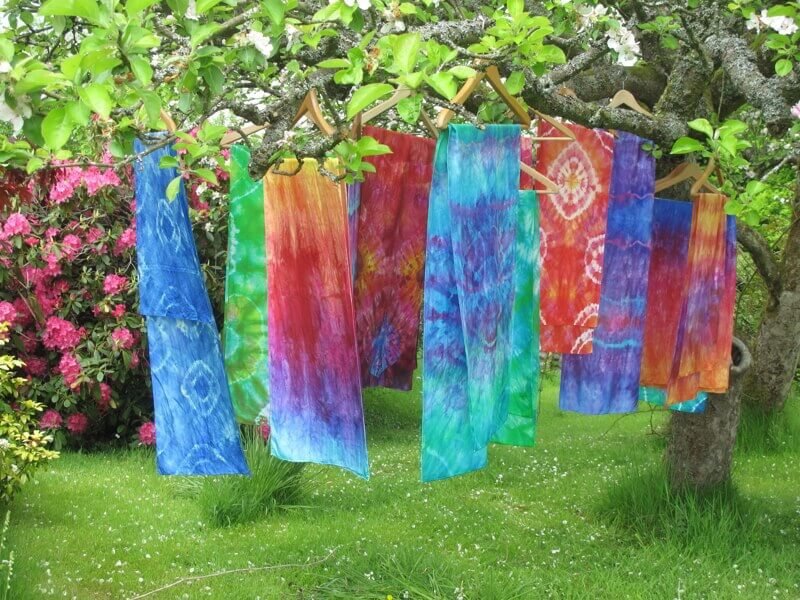
3.2 Pros and cons of fabric dyes
A key advantage of fabric dyes is their ability to preserve the fabric’s original texture and drape. They also infuse the fabric with color at a deeper level, resulting in exceptional colorfastness and resistance to fading. Dyes are the preferred choice for projects involving large fabric pieces or when a uniform, all-over color change is desired.
However, the dyeing process generally involves more extensive preparation and a more complex procedure than painting. Creating highly intricate designs with dyes can be more difficult. Also, both the type of fabric and its original color can substantially influence the final result, particularly when comparing natural versus synthetic fibers.
Practical Consideration: Selecting the appropriate dye type for your specific fabric is crucial for success. For example, fiber-reactive dyes like Procion MX are excellent for cotton and linen. Acid dyes are formulated for protein fibers like silk and wool. Dyeing synthetic materials like polyester requires disperse dyes, typically used with higher temperatures.
4. Choosing the right fabric: The foundation for success
4.1 Best fabrics for fabric paints
Fabric paints work well on various materials, but natural fibers like cotton, silk, and linen often deliver the best results as they absorb paint well, leading to vibrant colors. Cotton is particularly popular due to its affordability and ease of use. While natural fibers are ideal, specific “multi-surface” fabric paints are designed for synthetic materials like polyester and nylon, though colors may be less vibrant.
Regardless of fabric type, always pre-wash to remove residues that can hinder paint adhesion. For enhanced durability, heat-set the fabric after painting if the manufacturer recommends it.
4.2 Best fabrics for fabric dyes
Many fabrics can be dyed, but natural fibers like cotton, silk, linen, and wool yield the best results by absorbing dye deeply. Cotton (especially PFD cotton) is well-suited to fiber-reactive dyes, while silk and wool work best with acid dyes. For synthetic fabrics, you’ll need specific dyes; for example, polyester needs disperse dyes, while nylon can use acid dyes.
4.3 Understanding PFD (prepared for dyeing) fabric
PFD fabric is specially treated by removing dirt, oils, and finishes to ensure optimal dye absorption. It is typically creamy white or off-white, as the lack of bleach helps achieve better dyeing results, especially with delicate colors. PFD fabric is commonly made from natural fibers ideal for dyeing, like cotton, silk, and linen.
When working with PFD fabric, handle it with clean hands to avoid contamination. After dyeing, rinse and wash thoroughly per the dye instructions to remove any excess dye and ensure colorfastness.
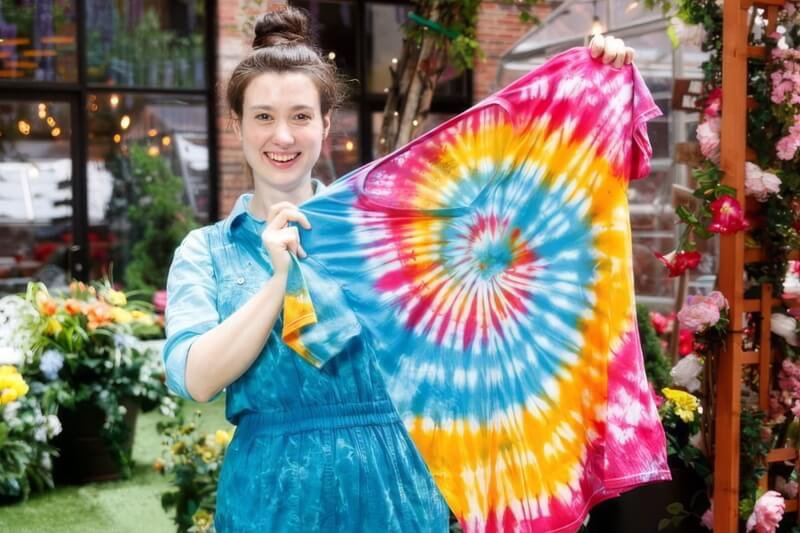
5. Factors to consider when choosing fabric paints and dyes
5.1 Fabric type compatibility
Different paints and dyes work best on certain fabrics. Always check the manufacturer’s guidelines for fabric compatibility. Matching the coloring agent to the fabric type is essential for successful and lasting results.
5.2 Colorfastness and washability
For lasting results, choose paints and dyes with excellent colorfastness that can withstand washing and sunlight without fading. Look for products labeled as “permanent fabric paint” and “wash-fast dyes,” especially for items that will be cleaned regularly.
5.3 Project goals and desired effect
Consider how the fabric will be used and the effect you want to achieve. For detailed designs, fabric paints are ideal due to their precision. Conversely, for all-over color or a tie-dye effect, fabric dyes are more suitable. Also, consider if you want a watercolor effect or a bold, opaque look, as paints and dyes offer different visual styles.
5.4 Safety considerations
Prioritize safety, especially in a home environment. Opt for non-toxic paints and dyes when possible, looking for low-VOC and skin-safe options. Always ensure good ventilation when working with dyes, especially powdered forms, to avoid inhaling fumes or particles.
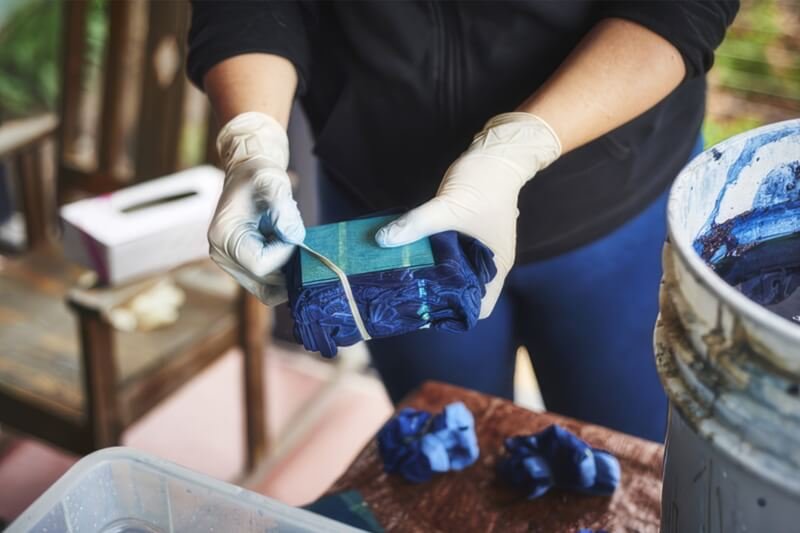
6. Top fabric paints: Brands and recommendations
Choosing the right brand can significantly impact your fabric painting experience. Here are some of the best fabric paint brands known for their quality and performance:
- Jacquard Textile Color Fabric Paint: This brand is highly regarded for its rich pigmentation and excellent coverage, ideal for bold designs on robust fabrics like cotton and canvas.
- Arteza Fabric Paint: Arteza is known for being versatile and affordable. It’s a good all-around choice for a range of projects and fabric types.
- Pebeo Setacolor Opaque Fabric Paint: Pebeo represents high-quality, vibrant paints favored by professionals. They are known for excellent lightfastness, making them suitable for projects requiring archival quality.
- Tulip Soft Fabric Paint: Tulip is a popular choice for its flexibility and minimal stiffness, making it great for clothing and wearable items where softness is important.
- Fabrico Dual-tip Fabric Markers: For fine details, Fabrico markers are incredibly convenient for line work and lettering, allowing for precise application and control.
- Jacquard Lumiere Fabric Paint: To add special effects, Lumiere paints are the go-to for metallic and pearlescent finishes, perfect for adding shimmer to your fabric art.
7. Top fabric dyes: Brands and recommendations
Just as selecting the appropriate paint is vital, choosing the correct dye is equally important. Here’s an overview of some leading fabric dye brands:
- Rit All-Purpose Liquid Dye: This dye is recognized for its user-friendliness and accessibility, serving as a good entry point for beginners dyeing cotton, linen, and fabric blends.
- Jacquard Acid Dyes: When working with protein fibers like silk, wool, and nylon, Jacquard Acid Dyes are a top choice, known for vivid, wash-fast colors that require heat setting.
- Procion MX Fiber Reactive Dye: This is the preferred option for tie-dye, batik, and shibori on cotton and other plant-based fibers. It’s celebrated for brilliant, wash-resistant colors and its ability to be used in cold water.
- Jacquard iDye Poly: This is a disperse dye tailored for synthetic materials like polyester and nylon. iDye Poly must be used at high temperatures for the color to correctly set.
- Indigo and Shibori Natural Dye Kit: For a traditional and eco-friendly method, these kits use natural dyes like indigo to produce classic blue shades, ideal for shibori techniques.
The best choice of dye depends on your fabric and desired outcome. Use fiber-reactive dyes for cellulose fibers, acid dyes for protein fibers, and disperse dyes for synthetics.
8. Proper storage of fabric paints and dyes: Maximize lifespan
To ensure your fabric paints and dyes remain usable, proper storage is essential.
8.1 Storing fabric paints
To properly store fabric paints, always close containers tightly to prevent them from drying out. Keep containers upright to avoid spills. Store them in a moderate temperature environment, away from direct sunlight, to prevent paint degradation and color fading.
8.2 Storing fabric dyes
Proper storage is equally important for dyes. Seal containers well, especially for powdered dyes, to prevent moisture absorption. Store them in a cool, dark place to protect them from heat and light. Ensuring powdered dyes remain dry prevents clumping and degradation. Always follow the specific manufacturer’s instructions, as some dyes may have unique storage needs.
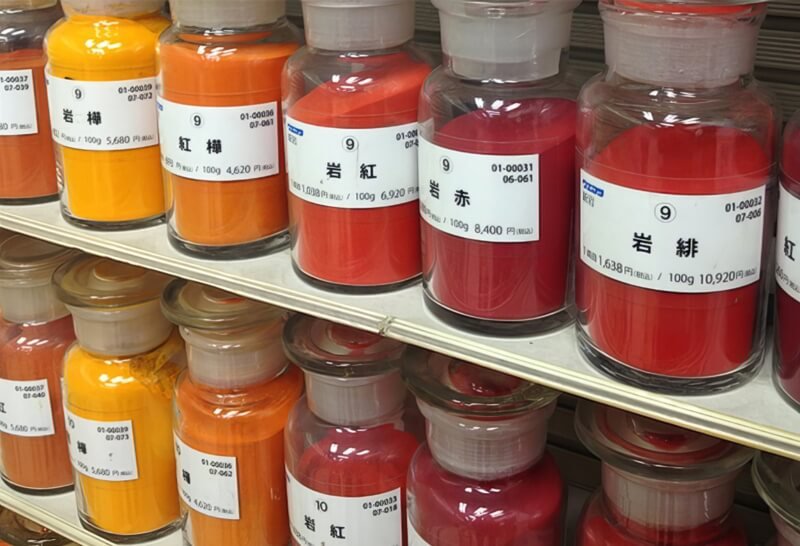
9. Painting with dye: Achieving a watercolor effect
For a uniquely soft and textured result, consider painting directly with dye. This technique allows you to mimic the delicate washes of watercolor while coloring fabric.
9.1 Supply list for dye painting
To begin, gather these essential supplies:
- Procion dye powder: Select your desired colors.
- Sodium alginate: A thickener to create a paintable dye base.
- Urea: To aid dye penetration and color vibrancy.
- Soda ash: Crucial for activating Procion dyes for fiber bonding.
- Natural fiber fabric: Choose cotton, linen, or silk for best dye absorption.
- Safety gear: Rubber or nitrile gloves and a dust mask.
- Paintbrushes: Various sizes for different effects.
- Containers: Plastic or glass containers for mixing.
- Miscellaneous tools: Plastic spoons, a bucket, tarp or cardboard for protection, and Synthrapol fabric detergent (optional) for the final wash.
9.2 Dye painting process and expert tips
First, mix soda ash into the thickened base (approx. 1 tsp per cup) to activate the Procion dye. In a separate container, mix the dye powder with a small amount of water to create a paste, then add this to the thickened base and stir well.
Apply the thickened dye to the fabric with your brushes to create your design. Once painted, let the fabric sit flat for 15–90 minutes for the dye to set; a longer time results in darker colors. After setting, rinse the fabric in cool water until the water runs clear, then wash with Synthrapol or a regular detergent.
Practical Advice: Remember that once soda ash is added, the dye mixture has a limited shelf-life of a few hours. Plan to paint shortly after mixing.
10. FAQs about fabric paints and dyes
10.1 What’s the main difference between fabric paint and fabric dye?
The primary difference lies in how they color fabric. Fabric paint sits on the surface, which can potentially make it slightly stiffer. In contrast, fabric dye penetrates the fibers, changing the fabric’s color while leaving it soft.
10.2 Can I use regular acrylic paint on fabric?
No, regular acrylic paint is not designed for fabric. It will likely crack and peel after washing. For fabric projects, always use paints specifically labeled “fabric paints” to ensure flexibility and durability.
10.3 How do I make fabric paint permanent?
Most fabric paints become permanent after heat setting. To ensure permanence, always follow the manufacturer’s instructions, which typically involve ironing the painted fabric. This process is crucial for wash-fastness.
10.4 What type of dye is best for tie-dye?
For tie-dye projects, especially on cotton, Procion MX fiber reactive dye is considered the best. It is favored for its vibrant, wash-fast colors, which are essential for tie-dye designs.
10.5 Can I dye synthetic fabrics like polyester?
Yes, but dyeing polyester requires specialized disperse dyes and a more complex process involving high temperatures. It is not as straightforward as dyeing natural fibers.
Read more:
Ultimately, choosing between fabric paints and dyes depends on your project. Fabric paints offer easy, vibrant surface designs. Dyes provide soft, ingrained color, ideal for all-over color and techniques like tie-dye. Equipped with this guide, you can now confidently choose and begin your fabric painting and dyeing adventures. So, experiment, explore techniques, and unleash your textile creativity!






















